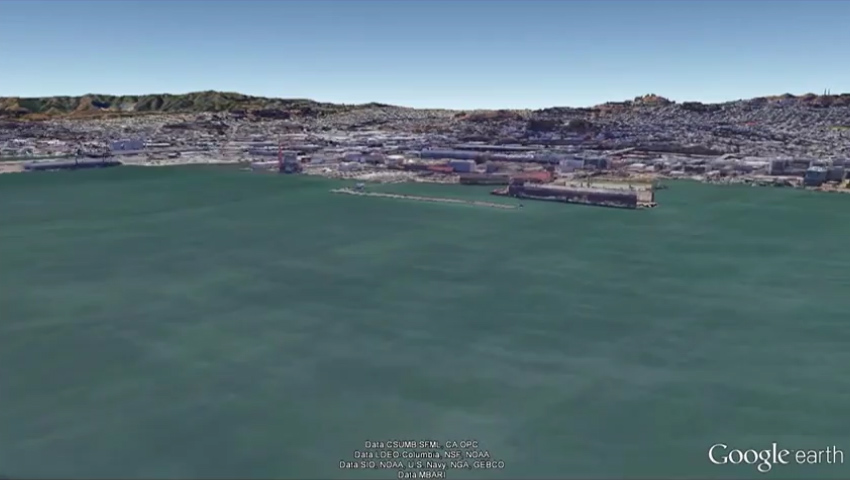Introduction
This is San Francisco’s beautiful Embarcadero Historic District.
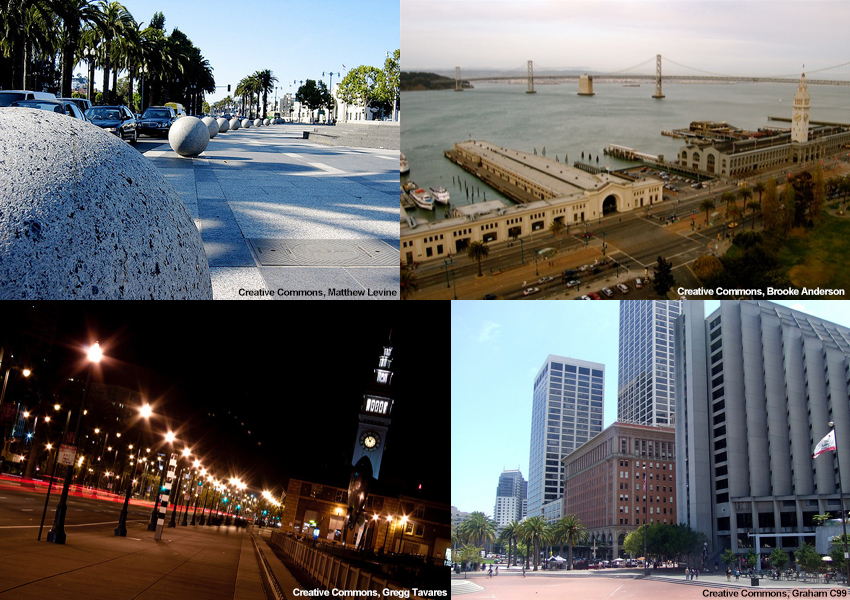
The National Trust for Historic Preservation named the Embarcadero as one of the most endangered historic places in the United States, reporting that “The district is facing two major physical threats: earthquakes and sea level rise. … These dual threats present enormous challenges to the future of the historic waterfront.”
endangered historic places Reference: "11 Most Endangered Places 2016": https://savingplaces.org/collections/11-most-endangered-2016 Viewed 10/18/2018.
Flood waters regularly encroach into the area due to high tides and storm surge. These high water levels threaten landmarks, transportation systems, and other infrastructure.
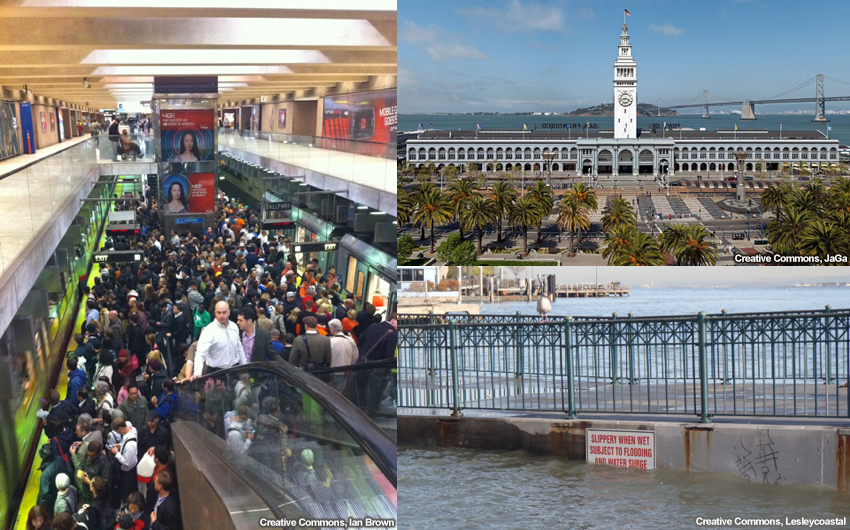
Left: Embarcadero Station, one of the busiest stations in the Bay Area Rapid Transit (BART) system. Upper right: The Ferry Building, an office building, marketplace, and station for ferries that cross the bay. Lower right: King tides at the San Francisco sea wall in the Embarcadero.
busiest stations Reference: Bay Area Rapid Transit: Ridership Reports. http://www.bart.gov/about/reports/ridership. Downloaded 10/18/2018.
Wise planning is needed for the Embarcadero area to remain resilient. How would you identify the vulnerabilities of infrastructure in the Embarcadero district?
The key to wise, long-term planning in relation to sea level rise is to visualize potential future water-level scenarios that may impact a project’s function or stability. These scenarios must consider not only rising sea levels, but also tides and storm surge.
Developing multiple future water-level scenarios for a project is a multi-step process. Several online tools can assist in this process, including USACE’s Sea Level Change Calculator and NOAA’s Sea Level Rise Viewer.
USACE United States Army Corps of Engineers
NOAA National Oceanic and Atmospheric Administration
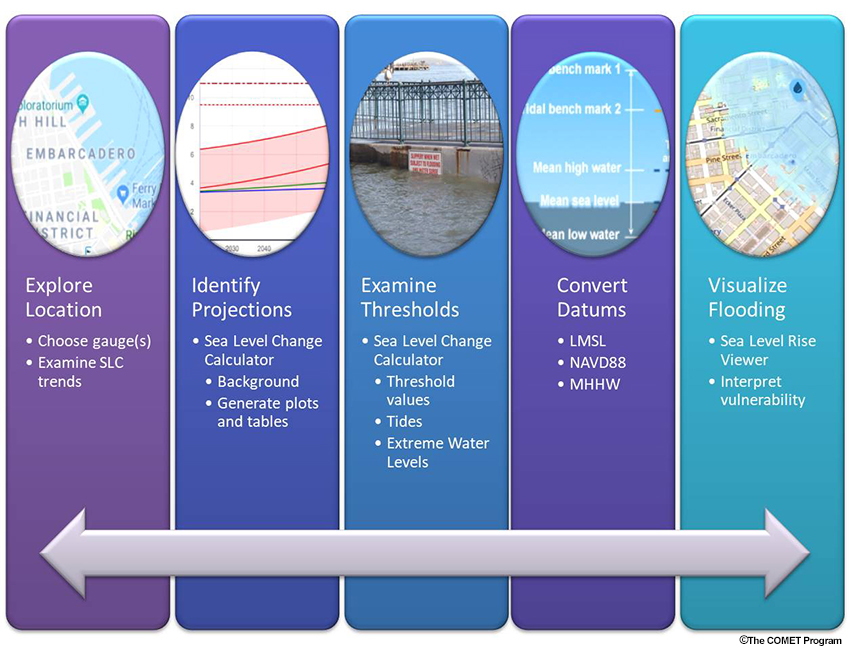
This lesson introduces these tools and the concepts behind using scenario-based planning for sea level rise. As an example, we’ll walk through a model project located in the Embarcadero.
Explore the location
The first step in analyzing the Embarcadero’s vulnerabilities to sea level change (SLC) is to locate the project and become familiar with its surroundings.
Question
Open Google Maps and type Embarcadero San Francisco, CA in the search bar. Outline the Embarcadero district on the following map. Draw a star on the Embarcadero BART Station, and on the intersection of The Embarcadero and Mission Street.

View this fly-through to further familiarize yourself with the Embarcadero and its surroundings.
Select a tide gauge
The next step is to identify the most relevant NOAA tide gauge, and note the relative sea level (RSL) trend that has been observed at that gauge.
relative sea level (RSL) Mean sea level determined at a tide station is referred to as local mean sea level (LMSL). Water levels are measured relative to a nearby benchmark, which serves as the station datum. However, the land surface itself may be rising or falling due to a variety of influences, natural and/or man-made. Thus, LMSL is also referred to as relative sea level. For more information, see Sea Level Change: Datums and Terminology. https://www.meted.ucar.edu/climate/sea_level_datums/navmenu.php?tab=1&page=3-0-0&type=flash
Go to NOAA’s Sea Level Trends page to identify the tide gauges near the Embarcadero.
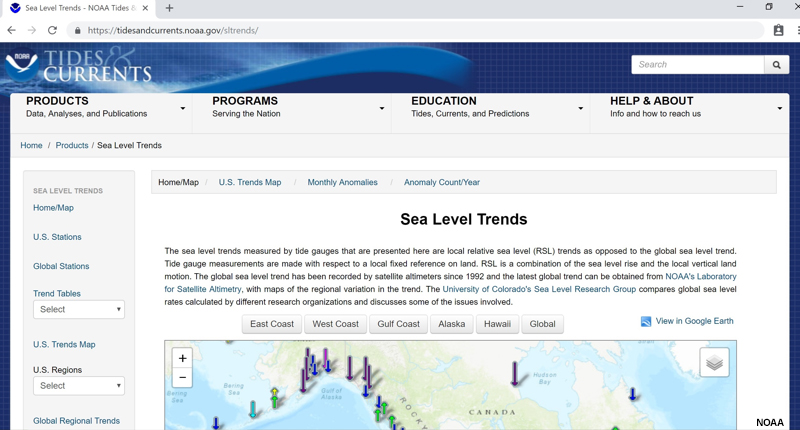
Zoom in to San Francisco by clicking the West Coast button, then the + button. You can drag the map to refocus it.
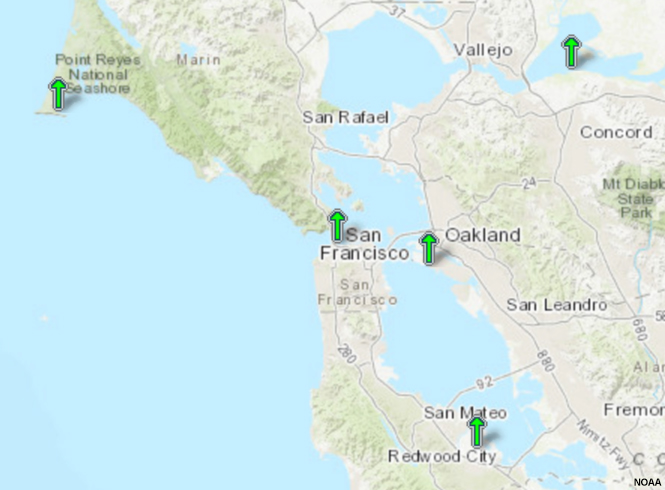
Several tide gauges near San Francisco are available for SLC analysis. NOAA has computed trends in RSL for these gauges using a minimum of 30 years of observations. For more information: Sea Level Trends page.
Question
What factors might you consider when choosing a tide gauge? Select all that apply.
When selecting a tide gauge to establish the RSL trend for your project, you may consider all of the factors in the above list, except the manufacturer that made the gauge.
Choosing a Tide Gauge
- Location - The closer the project is to a gauge, the more representative the relative sea level change is likely to be. However, local anomalies in vertical land movement should be evaluated.
- Rate of RSLC - If the project is between two different gauges and one gauge is exhibiting a more rapid sea level change rate, selection of that gauge will provide a more conservative estimate for future changes at the project site.
- Period of record - The longer the period of record, the more reliable the future SLC trend is expected to be. If there is a significant difference in length of record, that may be a factor in choosing a gauge.
- Datum Shift - If the MSL record shows a datum shift, caution should be exercised in calculating the total RSLC trend, however, the trend data can typically still be used.
Explore the tide gauges near San Francisco. On the Sea Level Trends page, click on the green arrows to see each gauge’s pop-up box. These boxes display long-term sea level trend information and plot options.
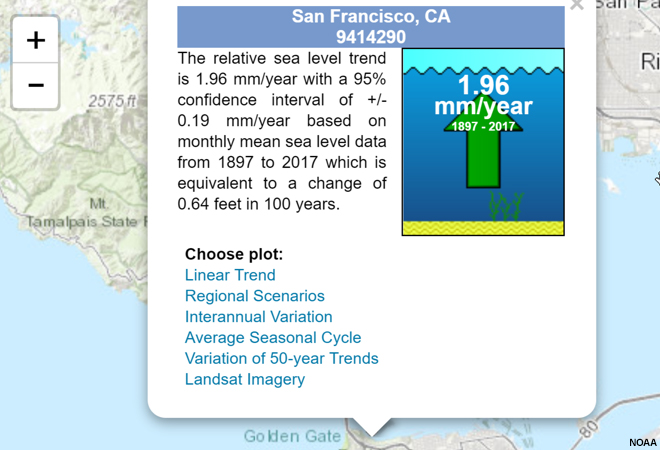
Question
Which tide gauge would you rely on most to gather information for the Embarcadero area?
The Embarcadero consists of densely developed infrastructure, so cautious planning is appropriate. Using the highest SLC rates observed nearby would lead to the most conservative plans. However, observed SLC rates are driven by both vertical land movement and atmospheric/oceanographic effects, which vary by location. Therefore, the San Francisco gauge most closely represents the full spectrum of conditions being experienced in the Embarcadero. For more information on SLC dynamics: Sea Level Change: Basics.
The choice of tide gauge for a SLC analysis involves many factors. For some projects, it may even be appropriate to combine data from multiple gauges. For this example, we’ll use data from the San Francisco gauge.
Explore the location »
Find the observed SLC
The next step is to investigate the historical SLC trend for the chosen tide gauge.
Click Linear Trend in the San Francisco gauge’s pop-up window.
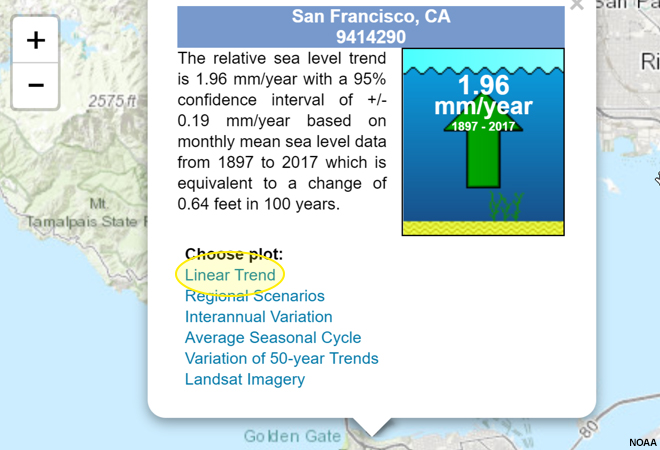
This brings up the Relative Sea Level Trend plot.
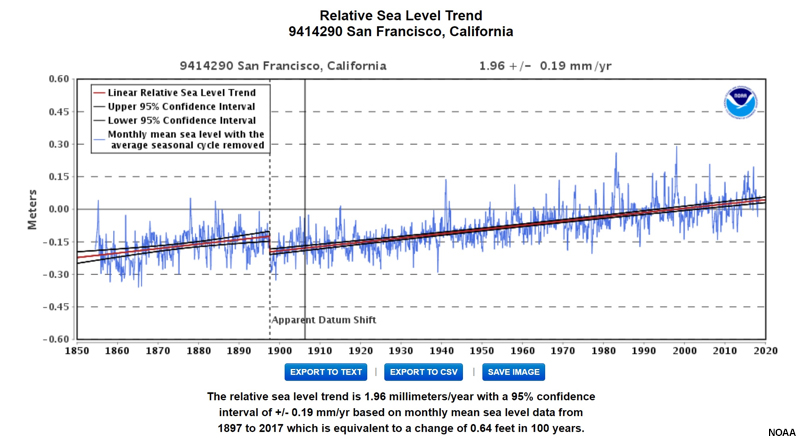
Use the RSL trend plot to answer the following questions.
Question 1
How many years of RSL data are available for the San Francisco gauge?
More than 100 years. The more data that is available, the more certainty we have concerning the historical RSLC trend. The period of record is quite long at the San Francisco gauge: more than 120 years of observations support the conclusion that the RSL at this gauge has been increasing at the rate of 1.96 mm/yr.
Question 2
What is the historical rate of change in RSL at the San Francisco gauge? Select all that apply. Hint
1.96 mm/year, which equals 0.64 feet per 100 years.
Question 3
Which of the following statements are true about the San Francisco gauge’s data record and how might that affect your choice of this gauge for your project analysis? Select all that apply. Hint
A, B, and C, are true. The length of the data record for this gauge makes it a reliable source for sea level trend projections. While the record includes both an earthquake and some other kind of datum shift around 1900 and 1910, the general trend of the sea level change remains consistent. So while a datum shift does not make the record more reliable, it does not necessarily mean that the trend produced from the data is not usable. If the data record is bisected by an event or a datum shift and trend lines on either side of the shift exhibit different SLC rates, the use of the data trend may be more in question.
Identify SLC projections
Now that you understand the Embarcadero’s geography and SLC trend, the next step is to identify projections of SLC using USACE’s SLC Curve Calculator.
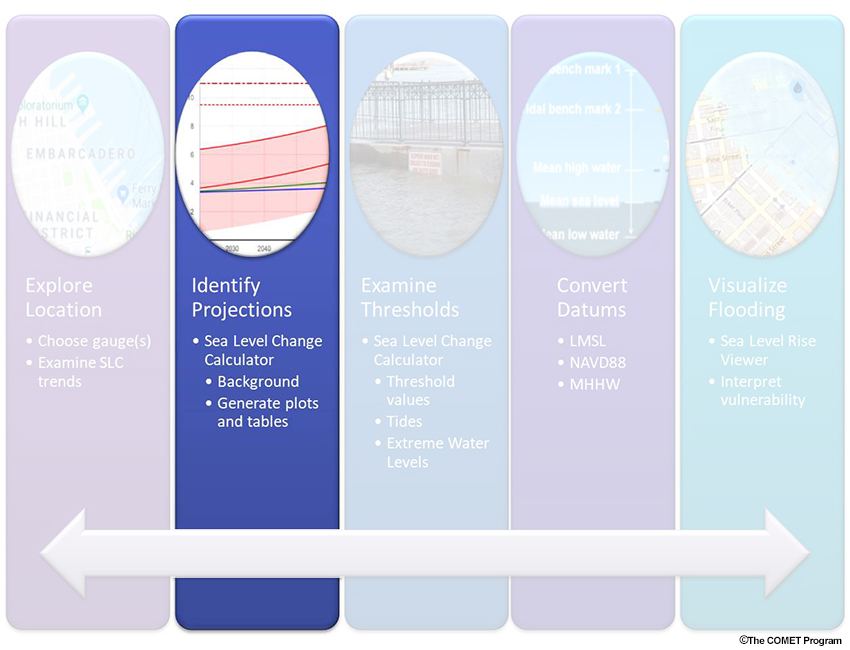
Identify SLC projections »
Enter project values
Go to the USACE SLC Curve Calculator (“the Calculator”).
The top of the page lists some background information and resources for the Calculator. Scroll down to the Calculator.
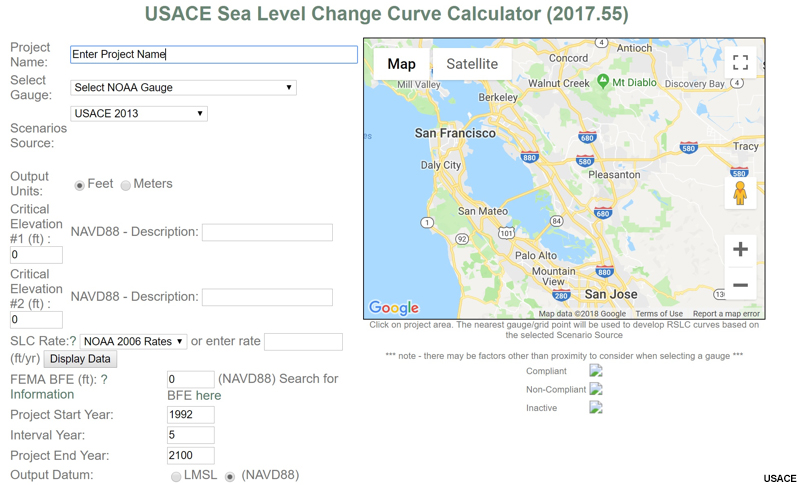
We will walk you through the steps to use the Calculator for the Embarcadero project. The Calculator’s Introductory Video and User Manual provide more information.
For the following Calculator fields, enter:
- Project Name: San Francisco Waterfront
- Select Gauge: San Francisco
- Scenarios Source: USACE 2013
- Output Units: Feet
- Project Start Year: 2020 Interval Year:
- Project End Year: 2120 (You’ll get an error--that’s okay*)
- Output Datum: LMSL (Local Mean Sea Level)
The data entries will look like this:
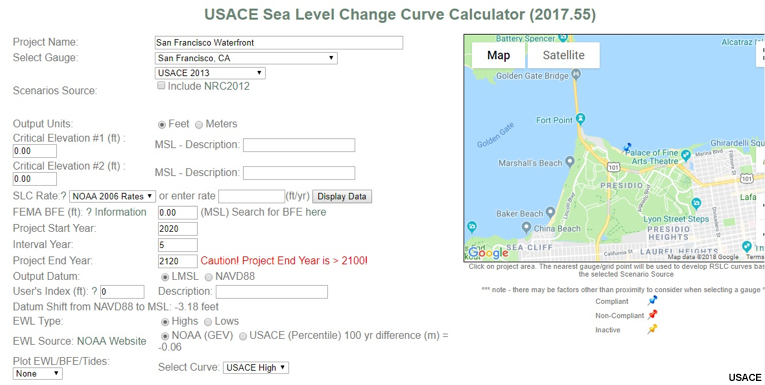
Question
What time frame are we analyzing for the Embarcadero project? Select all that apply.
All three time-frames are important. An economic period of analysis for a project is limited to 50 years, because economic forecasts beyond that time frame are not considered reliable. Infrastructure often stays in place well beyond 50 years, however, and may experience greater impacts of climate change than expected during initial project design. USACE guidance states that “…appropriate consideration should be given to environmental factors that may extend beyond the period of analysis” (ER 1105-2-100). Including analysis for a 50-100 year adaptation horizon improves planning robustness.
ER 1105-2-100 Reference: Planning Guidance Notebook, 22 April 2000. https://www.publications.usace.army.mil/Portals/76/Publications/EngineerRegulations/er_1105-2-100.pdf
*Note on “Project End Year” error: Because the SLC estimate that is provided by the Calculator is based on a given value of global SLC by 2100, the Calculator notes dates past this year. Also see Calculator Use Question #3.
Identify SLC projections »
Two RSLC projection plots
Once you enter project specifications, the Calculator displays two plots of the Estimated Relative Sea Level Change (RSLC) Projections.
The first plot displays the Estimated RSLC projections in terms of local mean sea level (LMSL) or NAVD88.
local mean sea level Tidal datums are based on tide gauge measurements and are only accurate for a limited area. For this reason, mean sea level determined at a tide station is referred to as local mean sea level (LMSL). For more information, see Sea Level Change: Datums and Terminology. https://www.meted.ucar.edu/climate/sea_level_datums/navmenu.php?tab=1&page=3-0-0&type=flash
NAVD88 North American Vertical Datum of 1988. For more information, see Sea Level Change: Datums and Terminology. https://www.meted.ucar.edu/climate/sea_level_datums/navmenu.php?tab=1&page=2-4-0&type=flash
The second plot displays the Estimated RSLC projections in terms of the magnitude of change in sea level through the project life. This plot is expressed in feet or meters. (The Calculator also produces a number of other charts which are not being used in this lesson.)
Interaction: Use the slider to compare the two Estimated RSLC plots for the project. Arrows added to the right of each plot represent the value of RSLC for each curve through the project life.
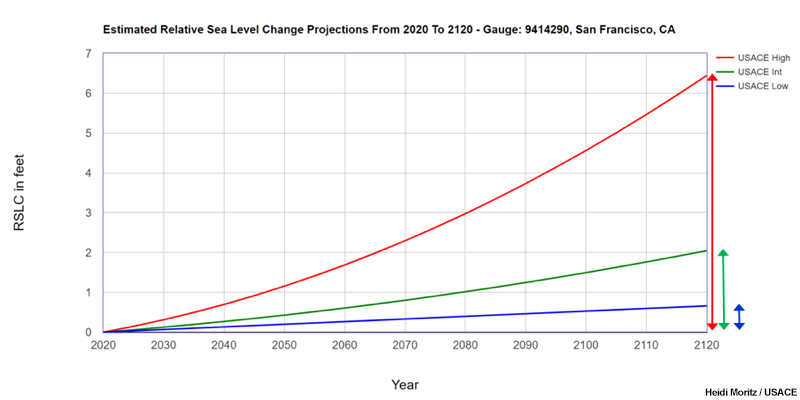
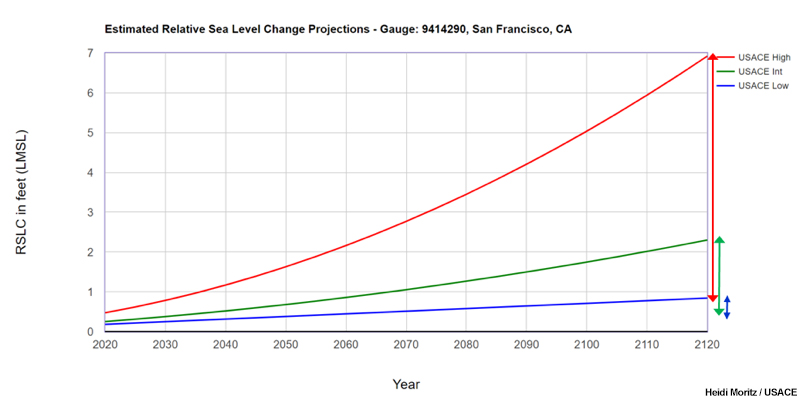
Question 1
Which of the following statements about the Estimated RSLC projections are true?
The two plots produced by the Calculator display the same Estimated RSLC projections. The plot displaying potential sea level elevations is referenced to a specific datum--either LMSL or NAVD88. The plot displaying the magnitude of potential RSLC over the project life starts each curve at zero magnitude in the project start year.
Question 2
Look at the top of the USACE SLC Calculator page to answer the following question.
The Low curve is the same curve that is in NOAA’s SLC Trend plot. (NOAA’s SLC Trend plot was the focus of this lesson’s preceding section.) This curve projects a linear trend based on the historical observations.
The Intermediate and High curves are projected based on the National Research Council’s Curve I and Curve III.
Identify SLC projections »
Sea level elevation
Scroll to the first plot on the Calculator page (Estimated RSLC - LMSL).
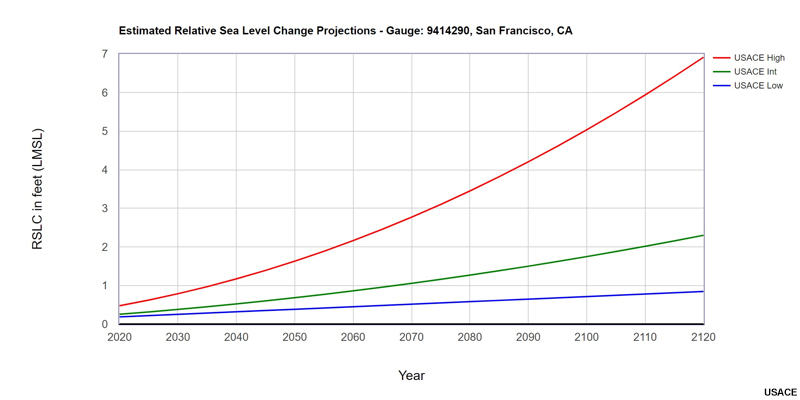
Question 1
Why do the curves in the Estimated RSLC plot not start at zero?
The curves begin in 1992 when the SLC projections start, based on the midpoint of the tidal epoch. In other words, the zero relative SLC value occurs at 1992. Thus, the curves will begin in 1992, regardless of the project start year that you enter.
Below the Estimated RSLC plot, you will find the following table of low, intermediate, and High projected values (in feet relative to LMSL). It is the same data as in the plot above, just in a different format.
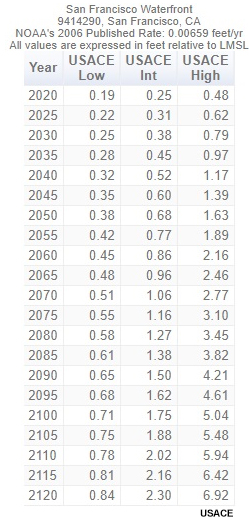
For each scenario, note the values at the project start (2020), 50-year economic period (2070), and the 100-year adaptation horizon (2120).
Question 2
What are the projected LMSL values for 2120?
Low: .84 ft
Intermediate: 2.30 ft
High: 6.92 ft
Question 3
Once you have found the RSLC for the gauge most relevant to your project, do you need to correct the values for vertical land movement?
No. The data comes from a tide gauge that is local and fixed to the earth, so the data includes the local land movement. In other words, each gauge captures relative sea level change for its location.
Identify SLC projections »
SLC magnitude
To find the magnitude of the projected change in sea level, look at the second Calculator plot (“Estimated RSLC - Project life”) and its data table. Scroll down to the second plot and table.
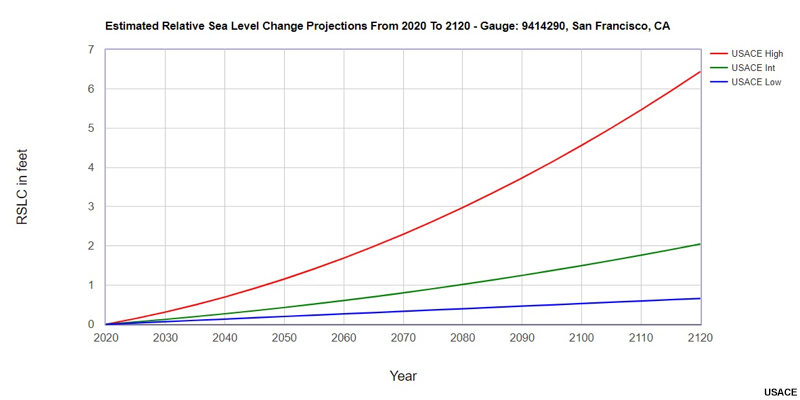
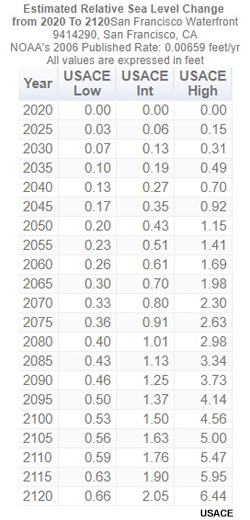
Question 1
According to the Low scenario, how many feet is sea level projected to rise during the economic period of the Embarcadero project?
0.33 feet
Question 2
How many feet does the Intermediate scenario project sea level to rise during the 100-year planning horizon?
2.05 ft
Question 3
How many feet does the High scenario project sea level to rise during the adaptation horizon (50-100 years)?
4.14 ft. To find the magnitude of projected change the adaptation horizon (50-100 years), subtract the 2070 values from the 2120 values.
Question 4
What is the approximate range of projected RSLC magnitude for the Embarcadero in 2120?
The Low projection for RSLC in 2120 for the project life is a rise of approximately 0.66 feet. The High projection is a rise of approximately 6.44 feet. The difference between the Low and High projection is close to 6 feet.
Question 5
Based on these projections, what SLC patterns will the Embarcadero district experience for the next 100 years?
The correct answer is “Cannot say.” In the past, planning studies were conducted with the assumption of stationarity--that the natural variability surrounding hydrologic and coastal processes will remain constant into the future. USACE policy promotes consideration of future nonstationarity, which is the principle that past patterns of change may not reflect future change patterns. The dynamic nature of climate change means that the future is uncertain. USACE has established multiple SLC curves to provide a scientifically sound representation of the range of possible future changes in a form suitable for taking action range of possibilities.
Question 6
What does the following chart emphasize about potential SLC in the Embarcadero district?
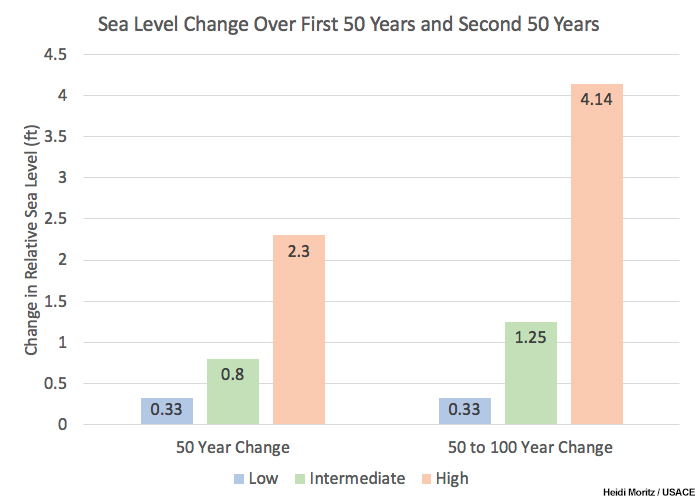
The High curve projects a 2.3-foot rise in sea level in the first 50 years, then an additional 4.14 feet of rise in the second 50 years.
A 6-foot range in projected SLC by 2120, and the potential for accelerating SLC, creates a very uncertain planning environment. Using the scenario approach helps manage this uncertainty. Managing potential future nonstationarity is the reason for USACE’s scenario-based policy:
“Consider… three scenarios”
“Planning studies and engineering designs over the project life cycle, for both existing and proposed projects, will consider alternatives that are formulated and evaluated for the entire range of possible future rates of SLC, represented here by three scenarios of “low,” “intermediate,” and “high” SLC.
Planning studies Reference: Engineering Regulation 1100-2-8162, “Incorporating Sea Level Change in Civil Works Programs” (Dec 2013)
Examine project thresholds and water levels
The next step is to use the Calculator to examine project thresholds and water levels.
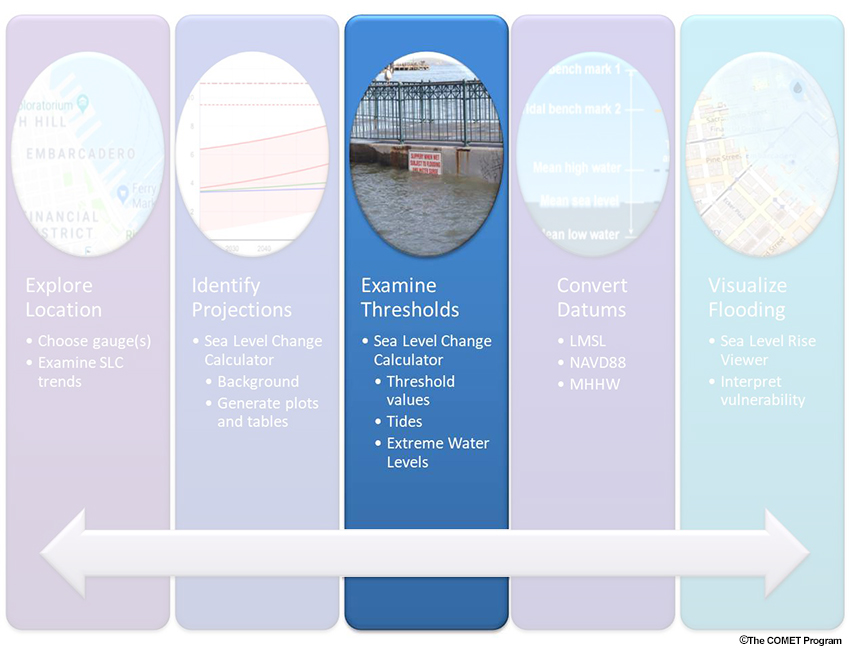
Examine project thresholds and water levels »
Determine thresholds
With an understanding of the potential SLC, we can examine how those changes may affect the Embarcadero.
The first critical elevation (threshold) for our example project is the intersection of The Embarcadero and Mission Street. This threshold has an elevation of 9.5 feet NAVD88. We will refer to this threshold as “the Intersection.”
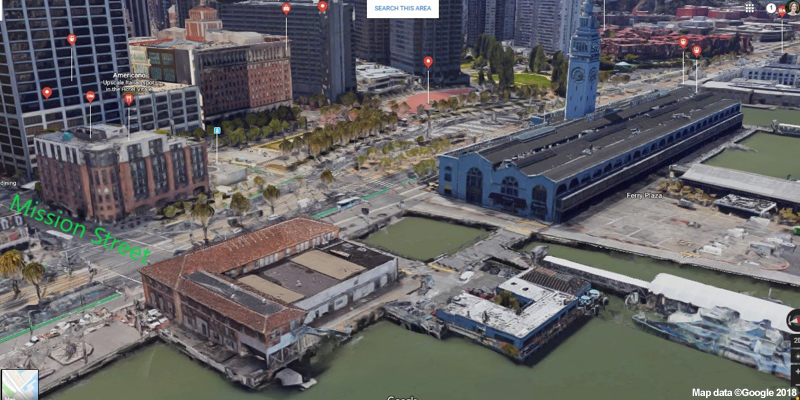
Question
Are the following statements true or false?
All three statements are true. It is especially important to note these tipping points, because the performance of the system can deteriorate rapidly once these thresholds are exceeded. Understanding thresholds can inform the urgency of action, the range of feasible actions, any necessary transition points from one type of measure to another, and the selection of extreme conditions for design, as well as larger system effects (Environment Agency, 2009).
Environment Agency, 2009 Reference: Environment Agency (2009), Thames Estuary 2100 Flood Risk Management Plan: Technical Report. London, United Kingdom: Environment Agency.
The second threshold for our model project is the Embarcadero BART Station (“the Station”), at an elevation of 11.0 feet NAVD88.
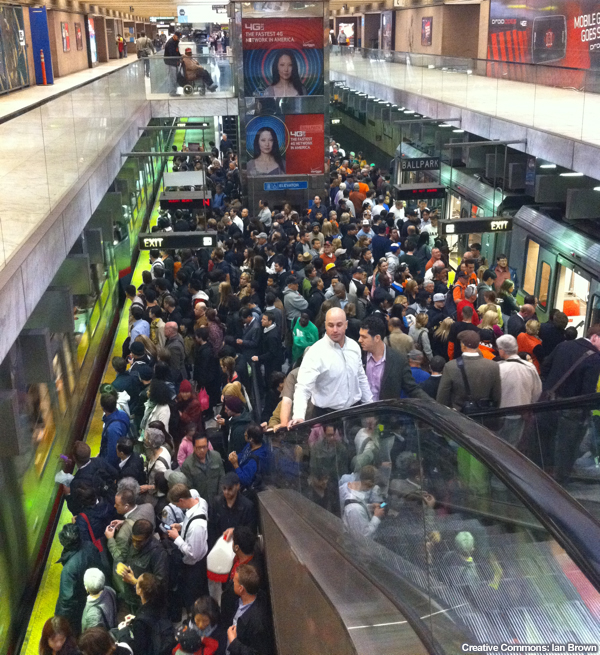
Notice that the project thresholds are referenced to NAVD88. The RSLC projections we examined earlier were referenced to LMSL. The Calculator will plot the projections in terms of either LMSL or NAVD88.
Return to the Calculator. For the Output Datum option, select the radio button for NAVD88. The RSLC Projections plot and table will now look like this:
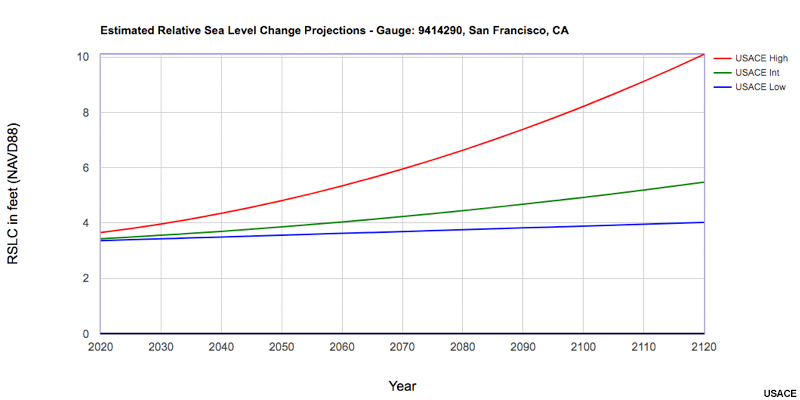
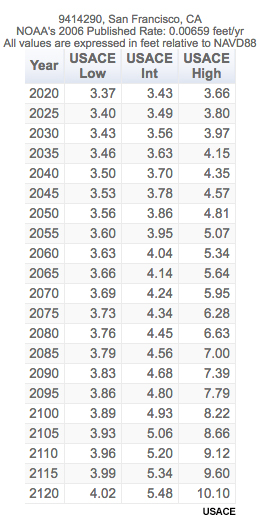
Question
When expressed in terms of LMSL, the Low curve projected a sea level of 0.19 feet in 2020. What is this sea level when expressed in terms of NAVD88?
3.37ft
Examine project thresholds and water levels »
Plot thresholds
Now enter the Embarcadero’s thresholds into the Calculator.
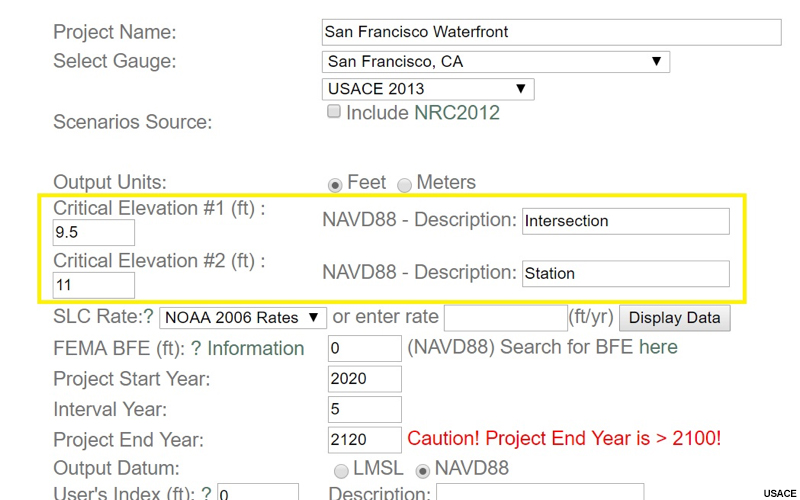
The Calculator adds the thresholds to the Estimated RSLC Projections plot.
(Note: Be sure to select the Output Datum--either LMSL or NAVD88--to which your threshold values are referenced before you enter your threshold values into the Calculator. If you switch the Output Datum after you enter your threshold values, the Calculator will convert the value from one datum to the other.)
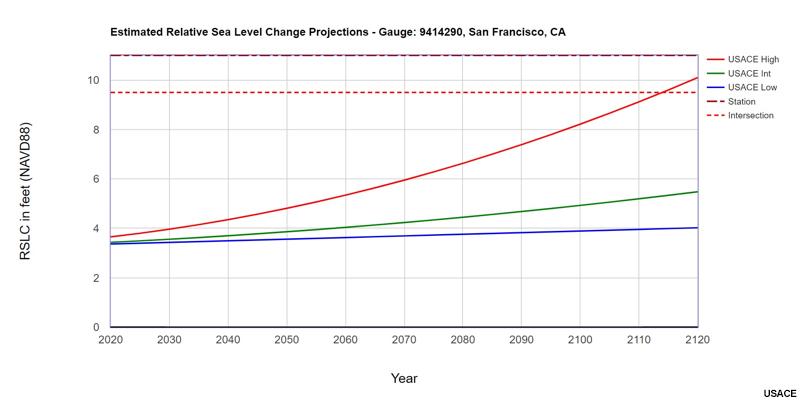
Question
Using the plot above, does SLC alone (without tides or extreme water levels) have the potential to overtop the Intersection and/or flood the Station? If so, in what year?
As shown by the yellow oval on the following plot, the High curve crosses the line for the Intersection threshold in 2113.
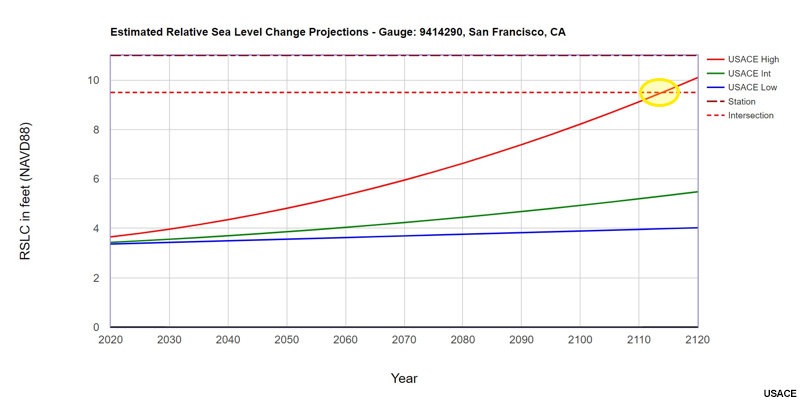
The Calculator also provides a table of the years in which each projection overtops the project thresholds.

Note that if you hover your mouse over a plot, the Calculator provides a pop-up with information on the data point. (The year may show with a comma, as it is here--2100 is shown as 2,100.)

Examine project thresholds and water levels »
Tidal range
We have seen how SLC alone may impact the key thresholds in the Embarcadero. The Calculator will also help you analyze tides. Tidal range in the Calculator is defined as the range from MLLW to MHHW. For background information on tides, see Introduction to Ocean Tides.
Return to the Calculator. Enter these values:
- Plot EWL/BFE/Tides: Tides
- Select Curve: USACE Int
With these values, the Calculator will project the tidal range along the Intermediate curve. Note that since you are plotting the tidal range (MLLW to MHHW), the shaded area is shown both below and above the RSLC curve which you have selected. For some projects (particularly ecosystem and navigation), it can be useful to also track what is happening to low water levels at a project location.
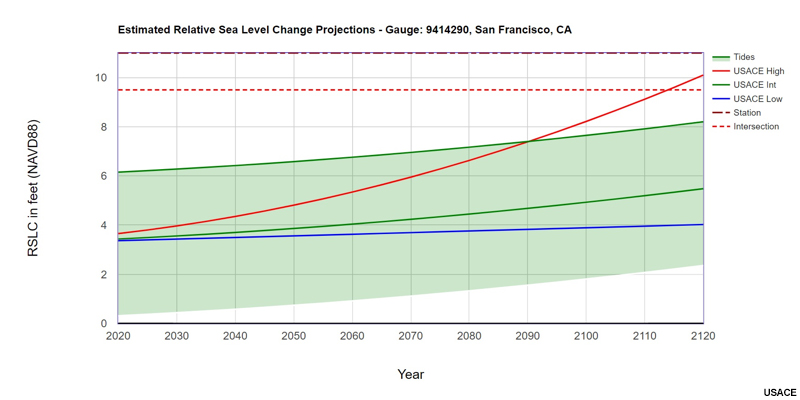
Question
According to the Intermediate projection, will MHHW as given by the tidal range overtop one of the Embarcadero project thresholds before 2120?
No. As shown by the yellow ovals on the following plot, the lines for the thresholds do not yet intersect with the tidal-range shaded area in 2120.
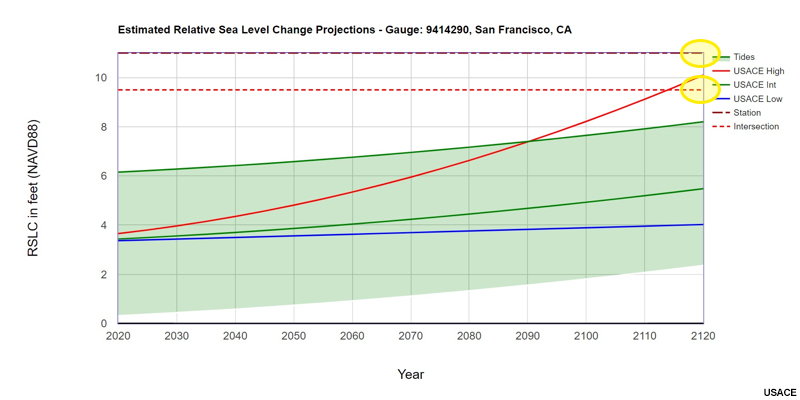
Return to the Calculator. Enter this value:
- Select Curve: USACE High
The Calculator now projects the tidal range along the High curve.
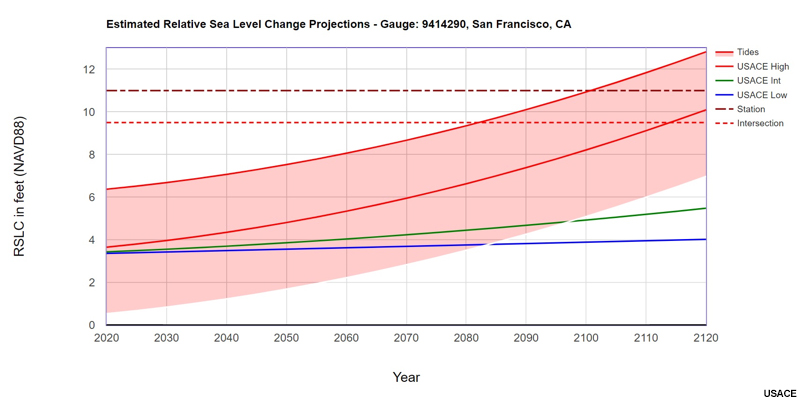
Question
As shown by the yellow ovals on the following plot, and by the table below, the High projection predicts that MHHW as given by the tidal range will overtop the Intersection in 2082 and the Station in 2100.
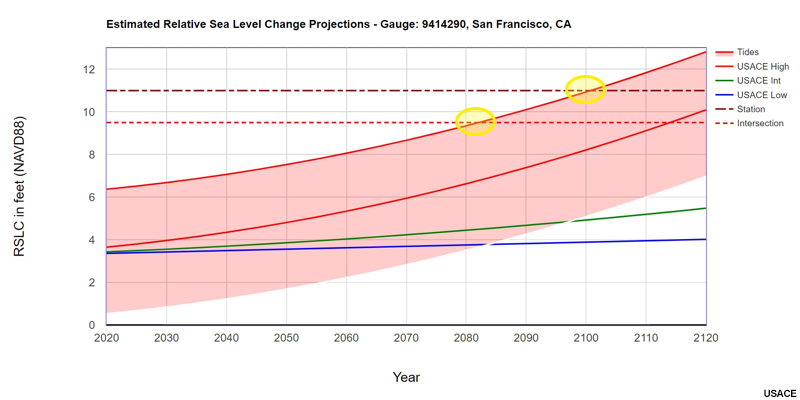

Examine project thresholds and water levels »
Extreme water levels
Now investigate how the extreme water levels (EWL) that threaten the Embarcadero relate to SLC. The EWLs are obtained from NOAA’s EWL estimates based on the historical record at the gauge location. For more information, visit Extreme Water Levels.
Return to the Calculator. Enter these values:
- Output Datum: NAVD88
- Plot EWL/BFE/Tides: 100 year
- Select Curve: USACE High
The Calculator will add the 100-year EWL to the High curve on the Estimated RSLC Projections plot.
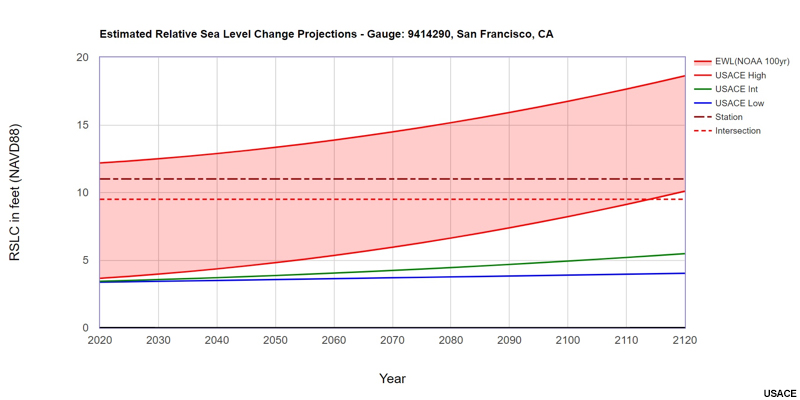
Question
According to the High projection, will a 100-year EWL event threaten the Intersection and/or the Station? If so, when?
As shown by the yellow ovals on the following plot, the 100-EWL range already overtops both thresholds in 2020.
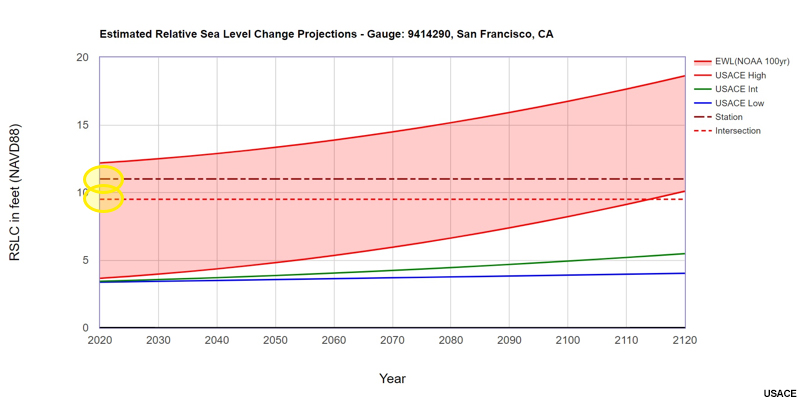
What about a much less extreme EWL? Return to the Calculator. Enter this value:
- Plot EWL/BFE/Tides: 1 year
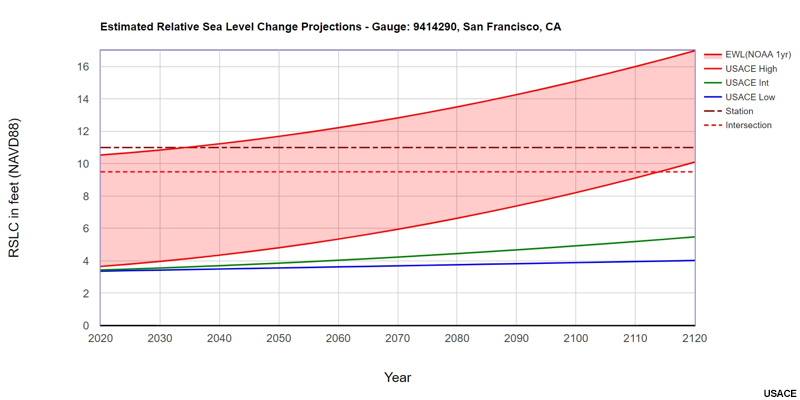
Question
According to the High projection, will a 1-year EWL event threaten the Intersection and/or the Station? If so, when?
As shown by the yellow ovals on the following plot, 1-year EWLs already overtop the Intersection threshold in 2020, and cross the Station threshold after 2030.
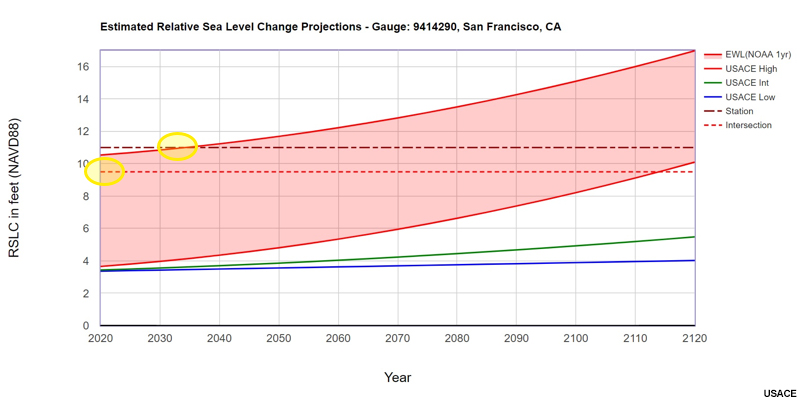
Visualization and datums
NOAA’s Sea Level Rise Viewer (“the Viewer”) supports the visualization of community-level impacts from coastal flooding or sea level rise.
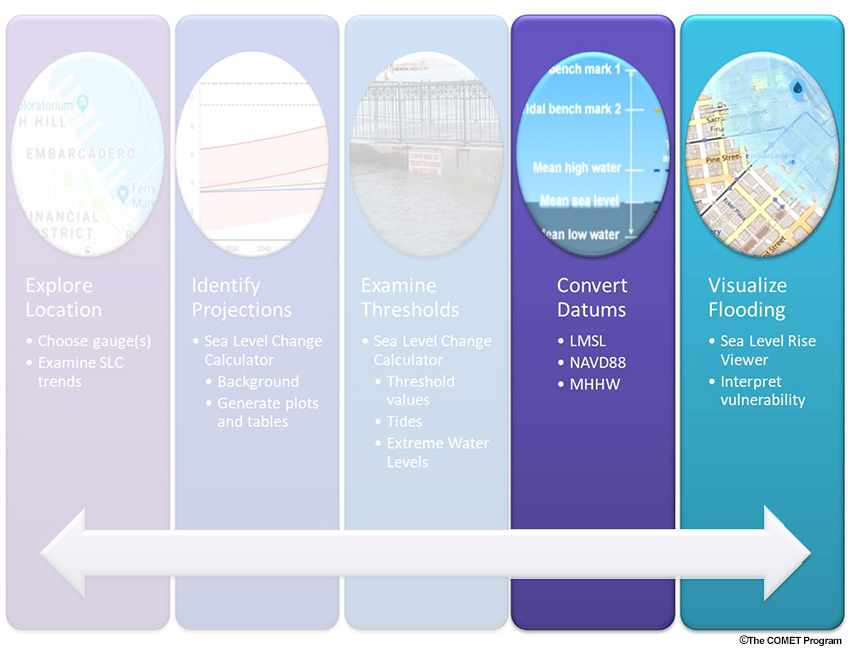
Go to the Viewer. For more information, visit Sea Level Rise Viewer.
Question
To which datum are the Viewer’s maps referenced?
As shown on the Viewer’s slider button, the Viewer’s flooding visuals are referenced to water levels in feet above MHHW for the current year.
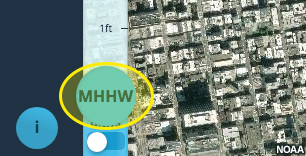
For more information on the Viewer, click the information button.
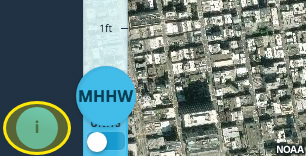
Visualization and datums »
Datum conversion
In order to visualize the project’s potential water levels, we need to convert the water levels from the Calculator from NAVD88 to MHHW. (For background information about datums, see Sea Level Change: Datums and Terminology.)
You can find datum conversion tables for your location on the NOAA Tides and Currents website, such as the following table for San Francisco:
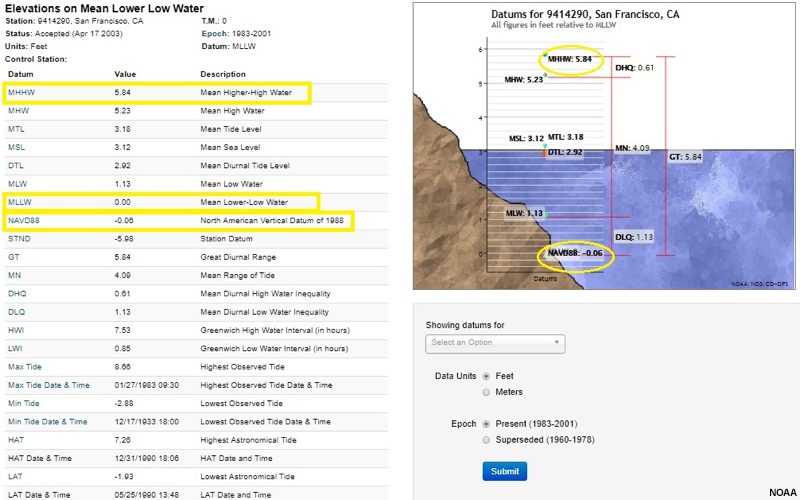
The information in the NOAA tables is referenced to MLLW. You can use the MLLW datum as a tool to convert NAVD88 to MHHW:
- The MHHW surface is 5.84ft above MLLW and the NAVD88 surface is .06ft below MLLW.
- The MHHW surface is therefore 5.9ft above the NAVD88 surface.
- To convert NAVD88 to MHHW, we subtract 5.9ft from any NAVD88 elevation to make it relative to MHHW.
To see the relationship to LMSL and to visualize the computations above, look at the following graphic. Notice that the MHHW surface is 5.90ft above the NAVD88 surface (3.18ft+2.72ft=5.90ft).
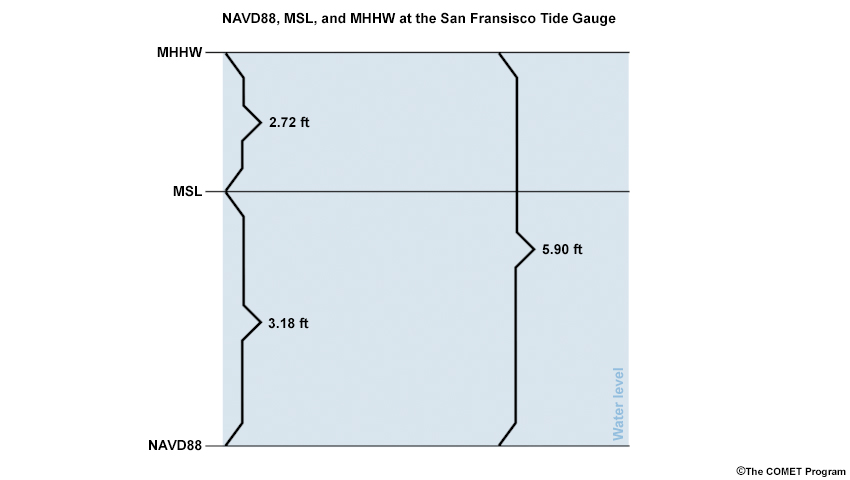
Question 1
What is 8.0ft NAVD88 expressed in terms of MHHW?
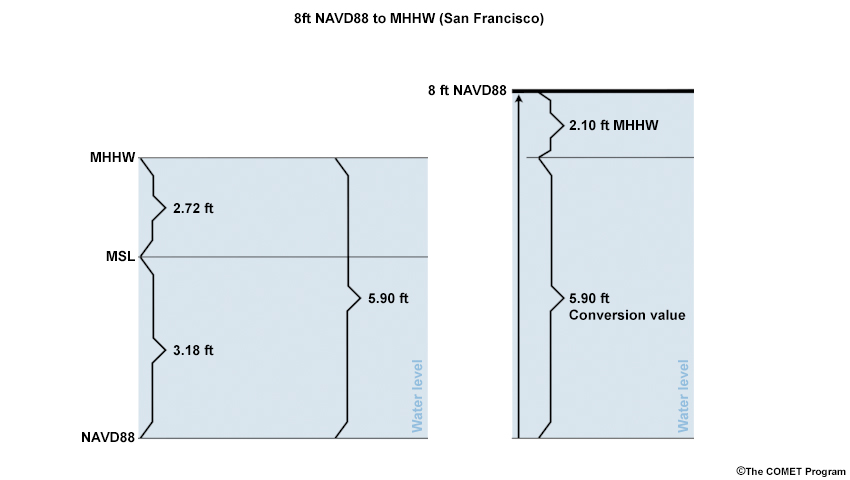
Question 2
The MHHW value as given by the tidal range for the High curve at 2120 is 12.82ft NAVD88. What value should we use in the Viewer to visualize the potential flooding?
Subtract 5.9ft to get the equivalent elevation in MHHW: 12.82 - 5.9 = 6.92. Note that these are water levels, and do not yet include wave processes.
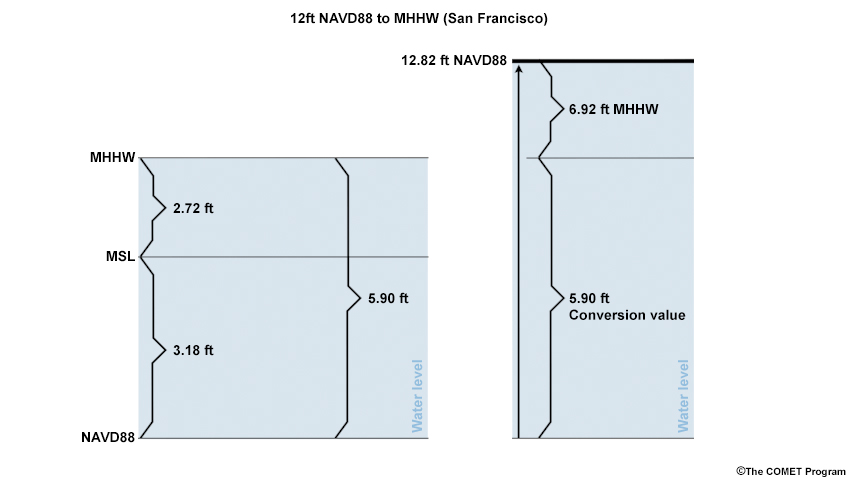
You may have values in MSL when you use the Calculator. The conversion process from NAVD88 to MHHW is conceptually the same as above, but using MSL, as shown here:
To convert 10ft MSL to MHHW using the information above you subtract 2.72ft from 10ft. So your value is now 7.28ft MHHW.
Visualization and datums »
Practice Datum Conversion
Question
Complete the following table:
(Type your answer in the boxes, then click Done at the bottom.)
| Description | NAVD88 (ft) | Conversion | MHHW (ft) |
| Low Scenario (MHHW from tidal range, 2120) | 6.74ft | -5.9ft | 0.84ft |
| Intermediate Scenario (MHHW from tidal range, 2120) | 8.2ft | -5.9ft | 2.3ft |
| High Scenario (MHHW from tidal range, 2120) | 12.82ft | -5.9ft | 6.92ft |
| Low Scenario (EWL-2120 -100 year) | 12.55ft | -5.9ft | 6.65ft |
| Intermediate Scenario (EWL-2120 -100 year) | 14.01ft | -5.9ft | 8.11ft |
| High Scenario (EWL-2120 -100 year) | 18.6ft | -5.9ft | 12.7ft |
| Threshold - Intersection | 9.5ft | -5.9ft | 3.6ft |
| Threshold - Station | 11ft | -5.9ft | 5.1ft |
Think about the Station and Intersection thresholds, and look at the values on the table above. On the next page, we explore what the projected water levels and the thresholds show you about the project’s vulnerability to flooding.
Visualize flooding
Visualize flooding »
Interpret vulnerability
Let’s explore the Embarcadero project’s vulnerability.
Question 1
We converted the 9.5ft NAVD88 Intersection threshold to 3.6ft MHHW. Think about the relevance of 3.6ft MHHW for this project. If we put this value in the Viewer, what do you think we will see?
Because 3.6 feet MHHW is the Intersection’s threshold, we would expect to see flooding at water levels above that. And in fact we do: the Viewer shows flooding at 4ft MHHW. (The Viewer only displays water levels in whole-number values, so we would need to enter 4ft MHHW.)

Areas that are hydrologically connected to the ocean are shown in shades of blue (darker blue = greater depth). Low-lying areas, displayed in green, are hydrologically "unconnected" areas that may also flood.
Question 2
Now consider MHHW as given by the tidal range for 2120, as predicted by the Low scenario. Will this water level cause flooding of the Intersection?
Because the Intersection’s threshold is 3.6 feet MHHW, and MHHW as given by the tidal range for 2120, predicted by the Low curve, is 0.84ft MHHW, we would not expect to see flooding at this water level.
The yellow ovals on the following RSLC plot show the same relationship in terms of NAVD88: the Intersection’s threshold is 9.5ft NAVD88, while MHHW as given by the tidal range for 2120, predicted by the Low curve, is 6.74ftft NAVD88.

Visualize flooding »
Use the Viewer
In order to visualize flooding using NOAA’s Sea Level Rise Viewer, we will need to focus next on scenarios that include predicted flooding.
Return to the Viewer. Enter Embarcadero, San Francisco, CA in the Viewer’s search bar.
Question 1
Move the Calculator’s slider bar to the 2120 MHHW level, as predicted by the High curve. Which of the following maps shows the result? What happens at the Station and the Intersection?
Map B is correct, showing potential flooding at 7ft MHHW. (Map A shows potential flooding at 5 ft MHHW.)
Question 2
Move the Viewer’s slider bar to the 2120 100-year EWL value, as predicted by the Intermediate curve. Which of the following maps shows the scale of potential flooding?
Map A is the correct answer, showing potential flooding at 8ft MHHW. (Map B shows potential flooding at 10ft MHHW, which is the maximum MHHW value the Viewer will display.)
Calculator use questions
The following concepts are important to keep in mind when using the Calculator to analyze potential impacts of SLC, tides, and EWLs.
Question 1
My project is on the open coast, and is subject to ocean waves. Once I have produced SLC curves and added NOAA’s extreme water levels using the Calculator, am I finished preparing High water scenarios for my project?
No. The values provided by the Calculator do not include other water level components such as wave run-up and set-up, riverine surge, or open-coast surge values. You must add relevant additional water level components to the shift in water level datum caused by SLC, tides, and EWL, and translate those values into what they mean for your project.
Question 2
You prepared a report that includes the three scenarios for the SLC that your project may face. After reading your report, a stakeholder asked, “What is the probability of getting these levels of SLC?” Can you provide a probability for the SLC projections?
The Calculator was developed to illustrate the scenario approach for SLC projections. Within the approach, the range of possible values is provided; the probability of getting any one value is not.
Question 3
You have been asked to prepare SLC and EWL projections for a 100-year planning horizon for a large infrastructure project. Should you add caveats to the information produced?
It is important to note that the 3 curves are created using different information. The Low SLC curve is a projection of the historical observed data. The Intermediate and High curves include expected increases due to future ice sheet melting and oceanographic changes, for which the rates of change are uncertain, though the scientific understanding is evolving.
Some tide gauges, such as the San Francisco gauge, have about 100 years of data. So theoretically, you could project the Low SLC curve and the EWLs (which is an extrapolation of the historical record) 100 years into the future for that gauge.
But the period of record available for some other tide gauges is less than 100 years, and sometimes is closer to the minimum length of record for sea level trends specified by NOAA, which is 30 years (USACE suggests that a 40-year period of record, which is representative of two tidal epochs, is preferable for sea level trend calculations). For these gauges, we recommend that the Low SLC curve should not be projected more than 120 years into the future.
There is less confidence projecting the Intermediate and High SLC curves past 2100, the end date for which they were developed. As period of record increases, the EWLs will become more confident. Likewise, as the science evolves, projections of the Intermediate and High curves will be updated, and there will be more confidence in the post-100 yr projected values.
Question 4
Why is the Calculator’s Project-Start-Date field pre-populated with the year 1992?
Keep in mind these two points:
- The user can change the Project-Start-Date to whenever their project is scheduled to start.
- Regardless of the Project-Start-Date entered into the Calculator, the SLC curves will still begin in 1992, since that is the midpoint of the last tidal epoch. Thus, for projects beginning after 1992, the plotted projection curves will begin above zero.
Question 5
Is the following statement true or false? The USACE SLC Curve Calculator will only plot the USACE Low, Intermediate, and High curves; it will not plot curves from other sources.
For Corps projects, at minimum, you must evaluate your project for the three SLC curves in USACE guidance (the Low, Intermediate, and High curves). In addition to these curves, the Corps encourages comparisons to other projections. The Calculator includes projections from several other sources. For example, the following plot shows projections produced by USACE, NOAA, and NRC.

Use the Scenarios Source pop-up menu in the Calculator to select the projections you would like to compare.
Summary
This lesson introduced the process of developing multiple scenarios of SLC focused on a specific project. The lesson guided exploration of tide gauges and projected observed SLC trends. The lesson then used USACE’s Sea Level Change Calculator to plot three scenarios of SLC, and added tides and EWL values. Finally, the lesson covered datum conversion and visualized the scale of potential flooding using NOAA’s Sea Level Rise Viewer.
The example project in the Embarcadero revealed a very uncertain planning environment, with a 6-foot range in potential sea levels by 2120, and the potential for accelerating SLC during the project’s adaptation horizon.
Using a scenario approach to planning helps manage high-risk uncertainty such as this. With wise and careful planning, we will be able to preserve cherished historical districts and create a robust and resilient future.
You have reached the end of the lesson. Please complete the quiz and share your feedback with us via the user survey.
USACE Guidance
- General: USACE Sea Level Change guidance proposes using scenarios representing different rates of possible future sea level change in order to inform risk-based decision-making at a project site. https://www.usace.army.mil/corpsclimate/Climate_Preparedness_and_Resilience/
- Datums: USACE, 2010. Standards and Procedures for Referencing Project Elevation Grades to Nationwide Vertical Datums, EM 1110-2-6056, Engineering Manual, Washington, D.C., USA. https://www.publications.usace.army.mil/Portals/76/Publications/EngineerManuals/EM_1110-2-6056.pdf?ver=2013-09-04-161354-967
- Policy: USACE, 2013. Incorporating Sea Level Change in Civil Works Programs, ER 1100-2-8162, Engineering Regulation, December 2013, Washington, D.C., USA.
- Technical Letter: USACE, 2014b. Procedures to Evaluate Sea Level Change: Impacts, Responses, and Adaptation, ETL 1100-2-1, Engineering Technical Letter, June 2014, Washington, D.C., USA. https://www.publications.usace.army.mil/Portals/76/Publications/EngineerTechnicalLetters/ETL_1100-2-1.pdf?ver=2014-09-03-115629-123
Contributors
COMET Sponsors
MetEd and the COMET® Program are a part of the University Corporation for Atmospheric Research's (UCAR's) Community Programs (UCP) and are sponsored by
- NOAA's National Weather Service (NWS)
with additional funding by: - Bureau of Meteorology of Australia (BoM)
- Bureau of Reclamation, United States Department of the Interior
- European Organisation for the Exploitation of Meteorological Satellites (EUMETSAT)
- Meteorological Service of Canada (MSC)
- NOAA National Environmental Satellite, Data and Information Service (NESDIS)
- NOAA's National Geodetic Survey (NGS)
- National Science Foundation (NSF)
- Naval Meteorology and Oceanography Command (NMOC)
- U.S. Army Corps of Engineers (USACE)
To learn more about us, please visit the COMET website.
Project Contributors
Project Lead
- Sarah Ross-Lazarov, Instructional Designer
Instructional Design
- Sarah Ross-Lazarov, Instructional Designer
Principal Science Advisors
- Heidi Moritz, P.E. Coastal Engineer Portland District, US Army Corps of Engineers
- Lis Cohen, COMET Associate Scientist
Science Advisors
- Jeffrey Arnold, USACE Climate Preparedness and Resilience Programs, Seattle, WA
- Kenneth Nowak, US Bureau of Reclamation, Denver, CO
Graphics/Animations
- Steve Deyo, Graphic Artist
Multimedia Authoring/Interface Design
- Gary Pacheco, Web Designer and Developer
Program Manager
- Tsvetomir Ross-Lazarov, Instructional Designer
COMET Staff, December 2018
Director's Office
- Dr. Elizabeth Mulvihill Page, Director
- Tim Alberta, Assistant Director Operations and IT
- Paul Kucera, Assistant Director International Programs
Business Administration
- Lorrie Alberta, Administrator
- Tara Torres, Program Coordinator
IT Services
- Bob Bubon, Systems Administrator
- Joshua Hepp, Student Assistant
- Joey Rener, Software Engineer
- Malte Winkler, Software Engineer
Instructional Services
- Dr. Alan Bol, Scientist/Instructional Designer
- Tony Mancus, Instructional Designer
- Tsvetomir Ross-Lazarov, Instructional Designer
International Programs
- Rosario Alfaro Ocampo, Translator/Meteorologist
- David Russi, Translations Coordinator
- Martin Steinson, Project Manager
Production and Media Services
- Steve Deyo, Graphic and 3D Designer
- Dolores Kiessling, Software Engineer
- Gary Pacheco, Web Designer and Developer
- Sylvia Quesada, Production Assistant
Science Group
- Dr. William Bua, Meteorologist
- Patrick Dills, Meteorologist
- Bryan Guarente, Instructional Designer/Meteorologist
- Matthew Kelsch, Hydrometeorologist
- Erin Regan, Student Assistant
- Andrea Smith, Meteorologist
- Amy Stevermer, Meteorologist
- Vanessa Vincente, Meteorologist
